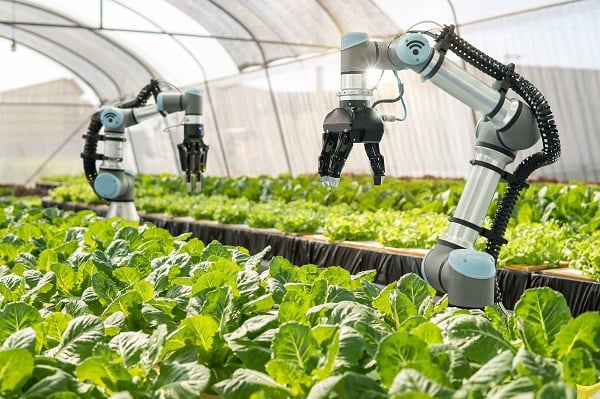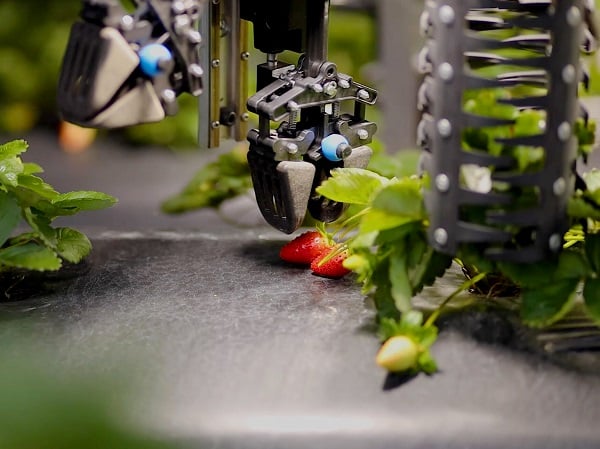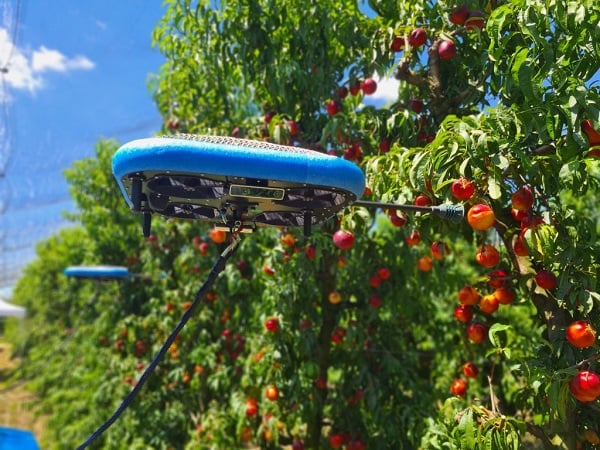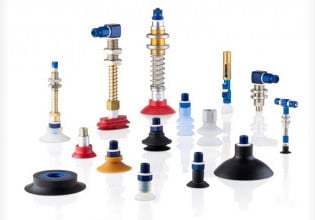Outstanding in the Field: Robots That Can Pick Fruit
Agriculture is an industry ‘ripe’ for technology, but what obstacles and opportunities lie in front of the cutting-edge innovators of the field?
Do I dare to pick a peach?
– with apologies to T.S. Eliot
Horticultural robots are arriving to handle the most delicate crops. Equipment manufacturers are taking advantage of recent advances in sensors, artificial intelligence (AI), and robotics to create autonomous systems that can identify specific fruits and vegetables, discern the difference between unripe and ripe examples, and gently pluck and package only those ready for harvesting.
A Linked History: Agriculture and Innovation
Agriculture has been a perpetual inspiration for technological innovation, from sophisticated irrigation systems created 5,000 years ago in Mesopotamia, to a seed drill invented 2,000 years ago in China, to the cotton gin patented relatively recently (in 1794) in the United States.
In the last few years, many of the most notable advances in agricultural technology have involved autonomous machines. Self-directing vehicles have been used to till farmland, sow seeds, monitor plant growth, and apply pesticides.
They have also been used to harvest crops, predominantly grains such as wheat, corn, and rice, but also soybeans and cotton. These crops have always been hardy enough to endure rough treatment from even some of the earliest and crudest agricultural machines.
More delicate crops, such as stone fruits (e.g. peaches, plums, apricots), tomatoes, and strawberries, on the other hand, are easily damaged. Even experienced farm laborers can bruise an apple or crush a berry with a brief moment of clumsiness.

Figure 1. Automated harvesting concept. Image used courtesy of Adobe Stock
Making a machine that can match the speed, dexterity, and practiced touch of an experienced farm worker is a formidable challenge, but circumstances are forcing the issue.
Addressing A Tough Labor Market
For at least the last two decades, farmers around the world have been complaining about the difficulty of finding qualified labor. "Even in agricultural hubs, for instance, California, where farm wages can sometimes top USD 20 per hour, high wages are not encouraging people to perform physically demanding and repetitive tasks, for instance, berry picking,” according to a 2023 report from research firm Markets And Markets.
Agricultural labor shortages have been exacerbated by politics. Often the most experienced farm hands are migrant laborers, but many of the countries where they used to find seasonal work have adopted immigration and trade laws that discourage the international movement of labor, if not restrict it outright.
The state of Georgia in the US passed a strict anti-immigration law in 2011; Georgia reported a shortfall of 11,000 workers that year and local farmers lost over $120 million on that harvest. The UK reported losing the services of 330,000 experienced farm laborers due to Brexit.
Farmers are in a bind for labor, and one of their few options for remaining in business is to automate. Big companies like John Deere and Komatsu tend to make autonomous tractors and harvesters for the most widely grown cash crops: wheat, corn, rice, soybeans, and cotton. Robotic systems for fruits and vegetables are scarce because the challenge has been so formidable.
Yet the need is acute, and a number of startups have formed to develop such machines. Some of the large industrial manufacturers are investing in some of these startups (Kubota and Bosch, for example), but farmers who grow fruits and vegetables are investing as well.

Figure 2. Grippers designed to delicately pick sensitive crops. Image used courtesy of Harvest CROO
Startup Profiles
Following are brief descriptions of some of the companies that have been founded in just the last 10 years to build horticultural robots. The examples provide an overview of the range of approaches being taken with manipulators and sensors.
Harvest CROO
Harvest CROO, founded in 2013 in Florida, has designed robotic modules equipped with manipulators – padded robotic clamps. The modules are mounted under the chassis of the company’s autonomous vehicle. CROO stands for computerized robotic optimized obtainer; it is no coincidence that the initialism is pronounced like “crew.”
Tevel Aerobotics Technologies
Tevel Aerobotics Technologies, founded in 2017 and based in Israel, makes aerial drones designed to pick fruits grown on trees, including apples, pears, and various stone fruits, using suction cups mounted on light booms. The drones twist fruits from trees and place them in the bed of an autonomous mobile collector to which they are tethered.
Ripe Robotics
Ripe Robotics, based in Australia, is developing a vehicle that it calls Eve, equipped with robotic arms for picking tree-borne fruit, such as apples. Eve’s arms are similarly equipped with suction cups for picking fruit.
Fieldwork Robotics
Fieldwork Robotics, based in the UK, has a similar vehicle equipped with four robotic arms capable of harvesting some of the most delicate fruits grown – raspberries. The robot vehicle carefully cups each individual berry and snips its stem.
Agrobot
Agrobot, based in Israel, has created an autonomous strawberry-harvesting vehicle equipped with robotic arms ending in pincers that are designed to grab the stems of each fruit and slice them off. The aim is to avoid having the manipulators ever touch the fruit.

Figure 3. Identifying and picking fruit from a flying platform. Image used courtesy of Tevel Aerobotics
Enabling Technology
Every horticultural robot employs optical sensors to first navigate through plant foliage to find the fruit, and then to identify ripe fruit. Most extant systems claim to employ AI, which they say is used to evaluate if a plant is whole, unblemished, and ripe for picking.
Computer vision systems are sometimes used in conjunction with radar, ultrasonic, and lidar. These additional sensors can be used for finding and evaluating fruit, of course, but they are also relied on for navigation. In many agricultural use cases (such as when picking berries typically planted in closely spaced rows), satellite-based navigation systems do not provide sufficient resolution. Harvest CROO, for example, states that its system relies on lidar to ensure its harvester avoids rolling over crops or colliding with human laborers and other obstacles.
A variety of manipulators have been adopted, including mechanical clamps, suction devices, attractors, needles, spray nozzles, and scissors to perform functions that include picking, harvesting, spraying, sowing, and transplanting.
These manipulators incorporate a wide range of actuators, including magnetostrictive, piezoelectric, pneumatic, electrostatic, shape memory alloy, ultrasonic, and even optical actuators.
Agricultural robots rely primarily on machine vision, but other sensors are employed. Force sensors are considered appropriate for machines that use clamps to harvest fruits of large volume and weight (by inference, that would include crops such as apples and melons). Spectral imaging could be used to improve crop recognition, localization accuracy, and precision.
Horticultural robots have provided an advantage over human laborers in one key way: their ability to collect data for subsequent analysis. These devices can provide precise data on the amount of fruit picked, as well as the weight and size of each fruit, complete with time stamps and geolocation. They can perform color grading, and provide information on the distribution of weight, size, and colors of various fruits in individual sorting bins. They can detect blemishes, disease, and pests, not just on the edible portions being harvested, but on the associated foliage.

Figure 4. Automated harvesting concept. Image used courtesy of Adobe Stock
Today’s Ag Robotics Market
The overall market for agricultural robots was projected to reach $13.5 billion in 2023 and grow to $40.1 billion by 2028, according to MarketsAndMarkets. The estimate includes a variety of systems that till, sow, and harvest, as well as provide plant monitoring and soil analysis. It also includes new systems being introduced to automate the process of milking cows; dairy farmers are as keen to automate as fruit & vegetable growers.
Most of the horticultural robots designed specifically for fruits and vegetables are only just now reaching the market, often for demonstration projects on commercial farms. Many more horticultural robots are being developed. Even with the latest sensors, actuators, and AI, harvesting fruits and vegetables is a challenge.
“[F]ruit picking robots still require development in sensing, manipulation, and soft robotics,” according to MarketsAndMarkets. “A typical fruit picking harvesting robot costs between USD 250,000 and USD 750,000, making it unaffordable for most farmers."
Even so, the interest among farmers in getting automated systems into their fields is high. MarketsAndMarkets expects driverless tractors and drones will likely become commonplace starting in 2025.






